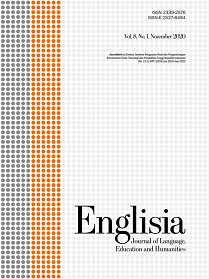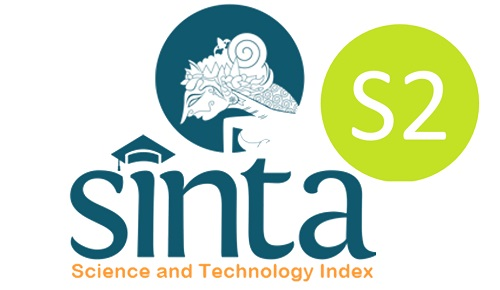Promoting students’ critical thinking through online learning in higher education: Challenges and strategies
DOI:
https://doi.org/10.22373/ej.v8i1.6636Keywords:
Critical thinking, online learning, higher educationAbstract
Living in the millennial era has encouraged all the learners to one step ahead maximizing the existed and updated technology for learning. Maintaining autonomous and long-distanced learning should have been introduced and implemented in higher education. Involving in an online learning environment is not enough without the ability to think critically. Critical thinking is the ability that is essentially required for learners in a higher education context. This paper discusses the challenges and strategies for implementing learners’ critical thinking through online learning. This paper used the literature study approach, in which all the information in this paper was obtained from books and journal articles. Briefly, the findings reveal that online learning can be good support for students to improve their critical thinking ability. However, there are also several challenges to do so involving the socio-cultural matter, the students’ previous learning habits, and the familiarity of using updated technology for learning. To end the discussion, the author provides several strategies to overcome those challenges. The well-designed online discussion (interactivity), critical-thinking learning content, and well-maintained instructions are several factors needed by online course instructors in order to improve their students’ critical thinking.
Downloads
References
Aizikovitsh, E., & Amit, M. (2010). Evaluating an infusion approach to the teaching of critical thinking skills through mathematics. Procedia-Social and Behavioral Sciences, 2(1), 3818-3822.
Arend, B. (2009). Encouraging critical thinking in online thread discussions. Journal of Educators Online, 6(1), 1-23.
Astleitner, H. (2002). Teaching critical thinking online. Journal of Instructional Psychology, 29(2).
Atkinson, D. (1997). A critical approach to critical thinking in TESOL. TESOL Quarterly, 31(1), 71-94.
Bai, H. (2009). Facilitating students’ critical thinking in online discussion: An instructor’s experience. Journal of Interactive Online Learning, 8(2), 156-164.
Carmichael, E., & Farrel, H. (2012). Evaluation of the effectiveness of online resources in developing student critical inking: review of literature and case study of a critical thinking online site. Journal of University Teaching & Learning Practice, 9(1).
Chang, Y. S. (2012). Student technological creativity using online problem-solving activities. International Journal of Technology and Design Education, 23, 803-816.
Chartrand, J., Ishikawa H., & Flanigan, S. (2009). Critical thinking means business: Learn to apply and develop the NEW #1 workplace skill. Pearson Education, Retrieved from http://www.talentlens.com/en/ downloads/whitepapers/ Pearson_TalentLens_Critical_Thinking_Means_Business.pdf
Clark, R. C., & Mayer, R. E. (2008). E-learning and the science of instruction: Proven guidelines for consumers and designers of multimedia learning (2nd ed.). San Francisco, CA: John Wiley & Sons, Inc.
Cobb, P., Wood, T., Yackel, E., & McNeal, B. (1992). Characteristic of classroom mathematics tradition: An interactional analysis. American Educational Research Journal, 29, 573-604.
Davies, M. (2015). A model of critical thinking in higher education. In M. B. Paulsen (Ed.), Higher education: Handbook of theory and research (pp. 41-92). https://doi.org/10.1007/978-3-319-12835-1_2
Duplass, J. A., & Ziedler, D. L. (2002). Critical thinking and logical argument. Social Education, 66(5), 10–14.
Ekahitanond, V. (2013). Promoting university students’ critical thinking skills through peer feedback activity in an online discussion forum. Alberta Journal of Educational Research, 59(2), 247-265.
Erikson, M. G. (2019, February). Supporting critical thinking in higher education: Consideration for strategic discussions. Paper presented at the 2019 European Learning & Teaching Forum of European University Association, University of Warsaw, Warsaw. Retrieved from: https://eua.eu/resources/publications/847:supporting-critical-thinking-in-higher-education-%E2%80%93-considerations-for-strategic-discussions.html
Facione, P. A. (1990). The Delphi report: Critical thinking: A statement of expert consensus for purposes of educational assessment and instruction. Millbrae, CA: California Academic Press.
Firdaus, Kailani, I., Bakar, M. N. B., & Bakry. (2015). Developing critical thinking skills of students in mathematics learning. Journal of Education and Learning, 9(3), 226-236.
Foo, S. Y. & Quek, C. L. (2019). Developing students’ critical thinking through asynchronous online discussion: A literature review. Malaysian Online Journal of Educational Technology, 7(2), 37-58.
Goodsett, M. (2020). Best practices for teaching and assessing critical thinking in information online learning objects. The Journal of Academic Librarianship, 46(5). doi: doi.org/10.1016/j.acalib.2020.102163
Habiburrahim, H. (2015). The internet and ICT: Opportunities or threats to the education world? Englisia: Journal of Language, Education, and Humanities, 3(1), 1-8.
Hadjerrouit, S. (2007). Using an understanding of the learning cycle to build effective e-Learning. In N. A. Buzzetto-More (Ed.), Advanced principles of effective e-Learning (pp. 27-58). Santa Rosa, CA: Informing Science Press.
Harvey, A., & Kamvounias, P. (2008). Bridging the implementation gap: a teacher-as-learner approach to teaching and learning policy. Higher Education Research and Development, 27(1), 31–41. doi:10.1080/07294360701658716.
Hasan, S., Tumbel, F. M., & Corebima, A. D. (2013). Empowering critical thinking skills in Indonesia archipelago: Study on elementary school students in Ternate. Journal of Modern Education Review, 3(11), 852-858.
Hew, K. F. (2015). Promoting engagement in online courses: What strategies can we learn from three highly rated MOOCS. British Journal of Educational Technology, 1-17. doi: http://dx.doi.org/10.1111/bjet.12235.
Indah, R. N., & Kusuma, A. W. (2016). Factors affecting the development of critical thinking of Indonesian learners of English language. IOSR Journal of Humanities and Social Science, 21(6), 86-94.
Jang, S. J. (2009). Exploration of secondary students’ creativity by integrating web-based technology into an innovative science curriculum. Computers and Education, 52, 247–255.
Khan, S. I. (2017). Critical thinking in a higher education functional English course. European Educational Research Journal, 6(1), 59-57. doi: 10.12973/eu-jer.6.1.59.
Kinne, L. J., & Eastep, S. M. (2011). Instructional design in online learning: Component of quality. Kentucky Journal of Excellence in College Teaching and Learning, (6)1. Retrieved from: https://encompass.eku.edu/kjectl/vol6/iss1/4
Krulik, S., & Rudnick, J. A. (1995). The new sourcebook for teaching reasoning and problem solving in elementary school. A Longwood professional book. Boston, MA: Temple University.
Kuhn, D. (1999). A developmental model of critical thinking. Educational Researcher, 28(2), 16-26.
Lloyd, M., & Bahr, N. (2010). Thinking critically about critical thinking in higher education. International Journal for the Scholarship of Teaching and Learning, 4(2), 1-16. doi: doi.org/10.20429/ijsotl.2010.040209
Lopez-Perez, M. V., Perez-Lopez, M. C., & Rodriguez-Ariza, L. (2011). Blended learning in higher education: students’ perceptions and their relation to outcomes. Computers & Education, 56(3), 818–826. doi:10.1016/j.compedu.2010.10.023
Lunney, M., Frederickson, K., Spark, A., & McDuffie, G. (2019). Facilitating critical thinking through online courses. Journal of Asynchronous Learning Network, 12(3-4), 85-97. doi: 10.24059/olj.v12i3-4.1686
MacKnight, C. B. (2000). Teaching critical thinking through online discussions. Educause Quarterly, 4, 38–41.
Mandernach, B. J. (2006). Thinking critically about critical thinking: Integrating online tools to promote critical thinking. InSight: A Collection of Faculty Scholarship, 1, 41-50.
Mandernach, B. J., Forrest, K. D., Babutzke, J. L., & Manker, L. R. (2009). The role of instructor interactivity in promoting critical thinking in online and face-to-face classrooms. Merlot Journal of Online Learning and Teaching, 5(1), 49-62.
McMillan, J. H. (1987). Enhancing students’ critical thinking: A review of studies. Research in Higher Education, 26(1), 3-29.
Meyers, C. (1986). Teaching students to think critically: A guide for faculty in all disciplines. San Francisco, CA: Jossey-Bass.
Ministerial Council for Education, Early Childhood Development, and Youth Affairs. (2008). Melbourne declaration on educational goals for young Australians. Canberra, Australia: Commonwealth of Australia.
Moon, J. (2007). Critical thinking: An exploration of theory and practice. New York, NY: Routledge.
Osborne, D. M., Byrne, J. H., Massey, D.L., & Johnston, A. N. B. (2018). Use of online asynchronous discussion boards to engage students, enhance critical thinking, and foster staff-student/student-student collaboration: A mixed method study. Nurse Education Today, 70, 40-46. doi: doi.org/10.1016/j.nedt.2018.08.014
Pahl, C. (2004). Data mining technology for the evaluation of learning content interaction. International Journal on E-Learning, 3(4), 48- 59.
Pane, N., Syahputra, E., & Mulyono. (2018). Improving the ability of creative thinking mathematically and self-confidence student through Application Model Eliciting Activities (MEAs) Review from Student Gender. American Journal of Educational Research, 6(4), 319-323. doi: 10.12691/education-6-4-4.
Paré, G., Trudel, M.C., Jaana, M., & Kitsiou, S. (2015). Synthesizing information systems knowledge: A typology of literature reviews. Information & Management, 52(2), 183–199.
Paul, R., & Elder, L. (2008). Critical thinking: Strategies for improving student learning, Part II. Journal of Developmental Education, 32(2), 34-35.
Peck, J. J. (2012). Keeping it social: Engaging students online and in class. Asian Social Science, 8(14), 81-90. doi: :10.5539/ass.v8n14p81.
Phirangee, K., Demmans, E. C., & Hewitt, J. (2016). Exploring the relationships between facilitation methods, students’ sense of community and their online behaviors. Online Learning, 20(2), 134-154.
Pyle, R. (1997). Teaching Critical Thinking Online. Retrieved from http://reach.ucf.edu/~aln/pyle/ main.html.
Ricci, A. F. (2009). Encouraging critical thinking in distance learning ensuring challenging intellectual programs. United States Distance Learning Association. 10(1), 1-15.
Samanhudi, U., & Sampurna, P. (2010). Researching students’ critical thinking in EFL writing class (a case study in English education department, Untirta). TEFLIN 57th Revitalizing Professionalism in ELT as a Response to Globalized World. Bandung, Indonesia: Indonesia University of Education.
Scriven, M., & Paul, R. (2003). Defining critical thinking: A draft statement prepared for the National Council for Excellence in Critical Thinking Instruction. Retrieved from: http://www.criticalthinking.org/University/defining.html.
Stapleton, P. (2001). Assessing critical thinking in the writing of Japanese university students: Insight about assumption and content familiarity. Written Communication, 18(4), 506-546. doi: 10.1177/0741088301018004004.
Stice, J. E. (1987). Developing critical thinking and problem-solving abilities. New Directions for Teaching and Learning, 30, 73-92.
Subkhan, E. (2012, September). Paradigm shifts on educational technology and its possibilities for transformative action. Paper presented in First International Conference on Current Issues in Education (ICCIE) held by Yogyakarta State University and National University of Malaysia, Yogyakarta.
Zainuddin, Z. (2015). Exploring the potential of blended learning and learning management system for higher education in Aceh. Englisia: Journal of Language, Education, and Humanities, 2(2), 70-85.
Zhang, L. F., & Sternberg, R. J. (2006). The nature of intellectual styles. Mahwah, NJ: Lawrence Erlbaum.
Downloads
Published
Issue
Section
License
Proposed Policy for Journals That Offer Open Access
Authors who publish with Englisia journal agree to the following terms:
- Authors retain copyright and grant the journal right of first publication with the work simultaneously licensed under a Creative Commons Attribution License that allows others to share the work with an acknowledgement of the work's authorship and initial publication in this journal.
- Authors are able to enter into separate, additional contractual arrangements for the non-exclusive distribution of the journal's published version of the work (e.g., post it to an institutional repository or publish it in a book), with an acknowledgement of its initial publication in this journal.
- Authors are permitted and encouraged to post their work online (e.g., in institutional repositories or on their website) prior to and during the submission process, as it can lead to productive exchanges, as well as earlier and greater citation of published work (See The Effect of Open Access).









